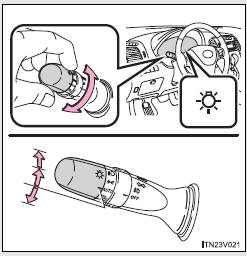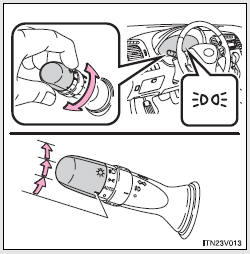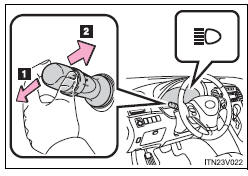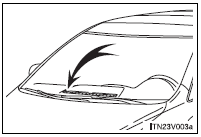Toyota Venza: Headlight switch
The headlights can be operated manually or automatically.
Turning the end of the lever turns on the lights as follows.
Type A

 The daytime running lights turn
The daytime running lights turn
on.

The headlights, parking lights, daytime running lights and so on turn on and off automatically.
(When the “ENGINE START STOP” switch is in IGNITION ON mode [vehicles with smart key system] or the engine switch is in the “ON” position [vehicles without smart key system].)
Type B

 The side marker, parking, tail,
The side marker, parking, tail,
license plate, daytime running lights and instrument panel lights turn on.
 The headlights and all lights listed
The headlights and all lights listed
above (except daytime running lights) turn on.
 The daytime running lights turn
The daytime running lights turn
off.
Turning on the high beam headlights

1. With the headlights on, push the lever forward to turn on the high beams.
Vehicles with Automatic High Beam: When the light switch is in
 position, the Automatic High Beam system
position, the Automatic High Beam system
will be activated.
Pull the lever back to the center position to turn the high beams off.
2. Pull the lever toward you to turn on the high beams.
Release the lever to turn them off.
You can flash the high beams with the headlights on or off.
- Daytime running light system
• To make your vehicle more visible to others, the high beam headlights turn on automatically at a reduced intensity (vehicles with halogen headlights) or the LED daytime running lights turn on automatically (vehicles with discharge headlights) whenever the engine is started and the parking brake is released. Daytime running lights are not designed for use at night.
Type A: Daytime running lights can be turned off by operating the switch.
• Compared to turning on the headlights, the daytime running light system offers greater durability and consumes less electricity, so it can help improve fuel economy.
- Headlight control sensor

The sensor may not function properly if an object is placed on the sensor, or anything that blocks the sensor is affixed to the windshield.
Doing so interferes with the sensor detecting the level of ambient light and may cause the automatic headlight system to malfunction.
- Automatic light off system
► Vehicles with smart key system • When the headlights are on: The headlights and tail lights turn off 30 seconds after a door is opened and closed if the “ENGINE START STOP” switch has been switched to ACCESSORY or OFF mode.
• When only the tail lights are on: The tail lights turn off automatically if the “ENGINE START STOP” switch is switched to ACCESSORY or OFF mode and driver’s door is opened.
To turn the lights on again, turn the “ENGINE START STOP” switch to IGNITION
ON mode, or turn the light switch off once and then back to the
 or
or
 position.
position.
► Vehicles without smart key system • When the headlights are on: The headlights and tail lights turn off 30 seconds after a door is opened and closed if the engine switch has been switched to “ACC” or “LOCK” position.
• When only the tail lights are on: The tail lights turn off automatically if the engine switch is switched to “ACC” or “LOCK” position and driver’s door is opened.
To turn the lights on again, turn the engine switch to the “ON” position, or
turn the light switch off once and then back to the
 or
or
 position.
position.
- Automatic headlight leveling system (Vehicles with discharge headlights)
The level of the headlights is automatically adjusted according to the number of passengers and the loading condition of the vehicle to ensure that the headlights do not interfere with other road users.
- Customization
Settings (e.g. light sensor sensitivity) can be changed.
NOTICE
- To prevent battery discharge
Do not leave the lights on longer than necessary when the engine is not running.
 Automatic High Beam
Automatic High Beam
The Automatic High Beam uses an in-vehicle camera sensor to assess the brightness
of streetlights, the lights of oncoming and preceding vehicles, etc., and automatically
turns high beam on or off ...
Other materials about Toyota Venza:
Cursor or Map Rotates when Vehicle Stopped
PROCEDURE
1.
CHECK CONDITION
(a) Check with the customer if the vehicle has been turned by a turntable.
OK:
Vehicle has not been turned by a turntable.
HINT:
If the vehicle is turned on a turntable with ...
Diagnostic Trouble Code Chart
DIAGNOSTIC TROUBLE CODE CHART
If a trouble code is displayed during the DTC check, check the trouble areas
listed for that code in the table below and proceed to the appropriate page.
Cruise Control System
DTC Code
Detection Item
...
Traffic Information is not Displayed
PROCEDURE
1.
CHECK DISPLAY
(a) Check which communication is not being used for displaying traffic information.
HINT:
Display of traffic information received via HD traffic is given priority while
in an "HD Radio" ...
0.1577

